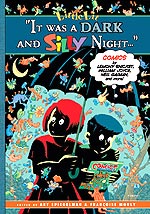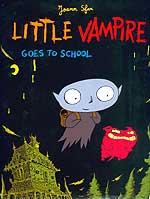
|
"It's a gateway drug," Spiegelman said by phone from his Manhattan studio. "[Comics] served to help our kids learn to love books as things as well as the ideas they contain." But after years of arguing that comics weren't just for kids, Spiegelman, author of the graphic novel "Maus," found himself in a peculiar position when trying to create "Little Lit." "[I]t was like finally some people were going, 'Yes! Comics are for adults,' and here we were kind of stupidly parading out into the battle zone going, 'Yeah but, wait, wait, comics aren't just for adults anymore. You've got to have comics for kids — it's important.'" Spiegelman sees a direct relationship between comics and kids learning to read. And for him reading is equal to "survival." " [Reading is] not just some stuffy notion like, 'Ah yes my kid will get into Harvard,' but what it really has to with is this: without a generation of verbally literate people I believe the gang in power can stay in power. You've got to read to be able to sort through all the stuff that's flying at you." Seen this way, giving children comic books becomes a civic duty.
While it's directed at kids, "Little Lit" volume three (RAW Junior; 48 pp.; $19.95) will charm adults by making them feel like kids again. Its large dimensions make yours hands look tiny in comparison. Inside is a delightfully colorful mix of short new comics along with puzzles like Barbara McLintock's lovely find-the-differences page. Even the stiffest octogenarian could not resist perusing the bear's picnic for missing apples and extra toes. The comics are by an interdisciplinary group of writers and artists, all of whose stories begin with the line "It was a dark and silly night." In the opening piece, children's author Lemony Snicket of the "Unfortunate Events" series, teams up with comix vet Richard Sala to create a tale about a Somewhat Intelligent, Largely Laconic Yeti, i.e. a SILLY. In a twist that will appeal to the wistful imaginings of independence not just limited to children, the yeti turns out to be a little girl completely covered in snow who lives in a cave, happily eating bark soup and marshmallows. For younger readers comic strip artist Patrick McDonnell, of "Mutts," turns in a charming confection about the moon's rather silly fear of the dark. Other contributions include the ghoulish tale of a children's graveyard party, written by Neil Gaiman ("Sandman: Endless Nights") and drawn by Gahan Wilson, a long-time "Playboy" and "New Yorker" cartoonist known for his grotesqueries. While the all-ages target of "Little Lit" means that some pieces are more difficult and other very simple, none of the works can be called un-intelligent or boring. It's a delight.

|
While "Little Lit" has been published by an imprint of HarperCollins, other traditional trade publishers are also exploring the children's comix genre. Simon and Schuster has just released two volumes of Frenchman Joann Sfar's wonderful "Little Vampire" series: "Little Vampire Goes to School" and "Little Vampire Does Kung Fu!" (30 pp.; $12.95 each.) Marketed to readers 10 and up, the first book begins when Little Vampire, feeling lonely at the haunted mansion with nothing but adult monsters and ghosts around, decides he wants to go to school. He goes at night, but sadly discovers no one is there. But he does the homework of a rather lazy little boy, Michael, who can't believe his good fortune in finding his homework miraculously done every night. Little Vampire and Michael soon meet and become friends, playing around with LV's pet, a pink, flying dog with an attitude named Hamzat. Much like Tim Burton's movie "The Nightmare Before Chistmas" Sfar's "Little Vampire" series turns creepy creatures into delightful characters. Sfar has a creative flare for the both the visualization of not-too-scary monsters and for smart stories that will surprise even older readers. At one point, while swearing an oath to protect the secret of the vampire family's existence, Michael declines to make the sign of the cross because he's Jewish. Perhaps most importantly, the books explore themes of personal responsibility, tolerance for others and self-reliance in clear but not overbearing ways we could only wish most adult literature would emulate.
Both the "Little Lit" and "Little Vampire" series make for smart introductions to reading comics. While "Little Lit" will appeal to early readers, the wit of "Little Vampire" will delight their slightly older siblings. Citing the Carl Bark's Donald Duck comics from the 1940s and 50s as "among the best stories for kids on paper," Spiegelman says Americans have lacked for comics you can re-read the way kids like to do. Hopefully these two series will provide the beginning a greater selection of kid's comics. "Kids, as we know, are ambi-tasterous," Spiegelman says. "They'll like lots of comics. They did in the past and they could again."
"Little Lit" and "Little Vampire" can be found at regular bookstores with smart children's sections.
